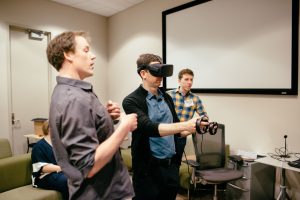 From reading political maps to selecting the ripest banana, color influences how we make judgments about our world. Assistant Professor and color cognition expert Karen Schloss knows something about that. As the director of the Visual Reasoning Lab in the Department of Psychology and Wisconsin Institute for Discovery, Schloss studies how we make conceptual inferences from visual information. Most recently, her work led to a National Science Foundation Early Career Award in 2020. Learn more about Schloss’s research in our Q&A and how she’s mentoring the next generation of scientists.
From reading political maps to selecting the ripest banana, color influences how we make judgments about our world. Assistant Professor and color cognition expert Karen Schloss knows something about that. As the director of the Visual Reasoning Lab in the Department of Psychology and Wisconsin Institute for Discovery, Schloss studies how we make conceptual inferences from visual information. Most recently, her work led to a National Science Foundation Early Career Award in 2020. Learn more about Schloss’s research in our Q&A and how she’s mentoring the next generation of scientists.
How did you become a color cognition researcher?
Ever since I can remember I was fascinated with color. One of my biggest concerns as a 4-year-old was how I could organize my crayons so they followed smooth gradation along the different rows in my crayon box. As I got older, I began to wonder about color preferences—why do different people have different preferences? Why do color preferences change over time? I also became curious about how color could be used to communicate meaning. As a psychology major at Barnard College, Columbia University, I took every opportunity to incorporate color into my class projects, from writing about color preferences for my term paper in a course on decision making, to conducting an experiment on color-coding and memory in a course on human memory, to investigating the role of color similarity in depth perception for my senior honors thesis. Once in graduate school at UC Berkeley, I got to dive into my own experiments studying the nature of color preferences, and now at UW-Madison my lab focuses on understanding how people infer meaning from colors in visual communication. Although my passion is in color, my lab aims to develop general principles of cognition that extend beyond color to other kinds of visual features (e.g., shape and texture) or perceptual features in other modalities (e.g., in touch and audition).
So many of us have color preferences; why is that? Where does that come from? Why does it matter?
My research suggests that preferences for a given color, say Badger Red, is determined by the combined preference for all concepts associated with that color. That is, people like colors that remind them of things they like, and they dislike colors that remind them of things they dislike. This account is called the Ecological Valence Theory. Through several experiments, we have found evidence supporting this theory. It can explain why individuals vary in their color preferences–if individuals have different preferences for the same objects, that can result in difference in preferences for colors associated with those objects. For example, if I hate brussels sprouts and you love them, and all else is equal, you will probably like green more than I do. The theory can also explain why color preferences change over time, like with changes in the seasons from summer to fall to winter.
How do we use color to communicate information in design?
People have expectations about the meanings of colors in information visualizations used for visual communication, and it’s harder for people to interpret visualizations when designs violate those expectations. So, a key challenge is understanding the nature of those expectations, which can be used to create designs that facilitate communication. Many factors contribute. On such factor is the dark-is-more bias, in which people infer that darker colors represent larger quantities. We can see this used effectively in the media these days, where maps of coronavirus data typically use darker colors to represent larger rates of cases, deaths, and vaccinations across the world.

You’ve started to bring Virtual Reality into the classroom. How is it being used and why is it valuable for your students?
Yes! My team in the Wisconsin Institute for Discovery Virtual Environments Group is developing virtual reality tools for education. In the UW Virtual Brain Project (in collaboration with Bas Rokers at NYU Abu Dhabi), we are creating interactive 3D diagrams of the human brain, based on real neuroimaging data. In these interactive virtual reality (VR) lessons, learners can travel from sensory organs (e.g., eyes and ears) along neural pathways to sensory cortex in the human brain, and learn about brain structures and function at “information stations” along the way. In my class, Psychology of Perception (Psych 406) we bring VR headsets into class so students can dive into this active way to learn about the brain while in the lecture hall. Evidence from a study in my lab suggests this method of learning is valuable for producing enjoyable experiences for engaging with the material.
What’s something you’re working on now that you’re particularly excited about?
As part of the Education Plan for my NSF CAREER award, my lab has started a long-term collaboration with Girls Inc. at the Goodman Community Center to broaden participation in science. We are working with a cohort of middle school youth at Girls Inc., the Girls Inc. leaders, and Discovery Outreach here on campus to incorporate youth voice for developing community engagement activities on color perception and information visualization. We will launch these activities at community events at UW-Madison and Goodman Community center, with the goal of making the materials broadly available to other educators around the world. Along the way, my lab is mentoring the Girls Inc. middle school cohort to support their interests and help build their STEM identity. We are excited to be mentoring the next generation of scientists!